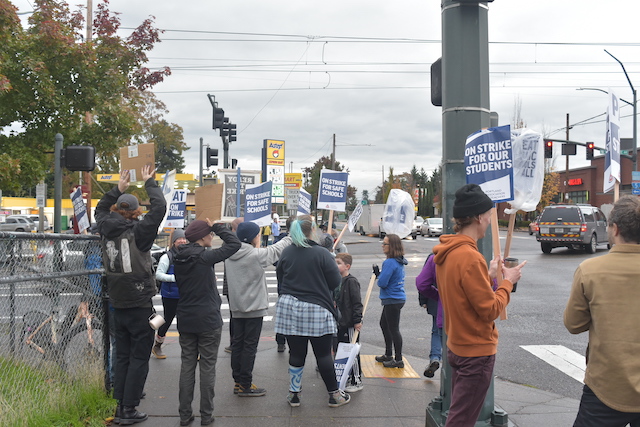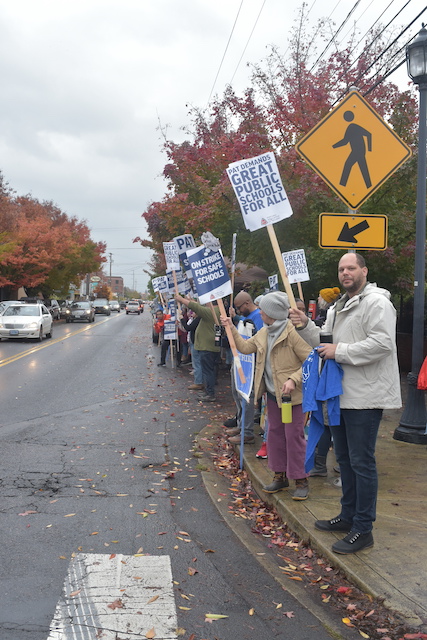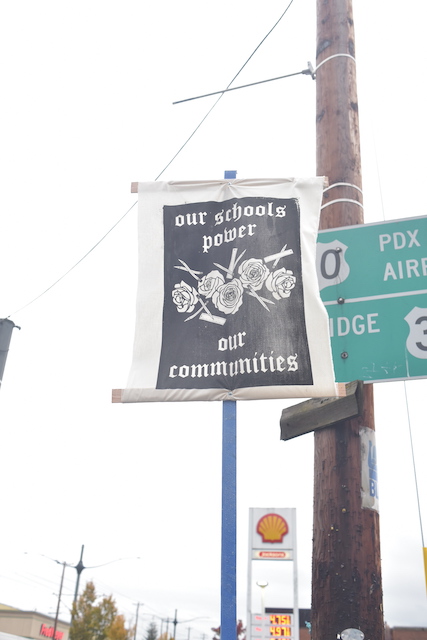
Story and photos by Pete Shaw
The nearly 4,500 members of the Portland Association of Teachers (PAT) walked out on strike on November 1. Classroom teachers from the district’s 81 schools came together with students, parents, and other supporters in the community to demand the Portland Public Schools (PPS) administration show respect for them and the students they teach. Among the PAT’s demands are smaller class sizes, more counselors and social workers for students, and greater support for students with learning disabilities. Teachers are also demanding increased salaries which reflect changes in cost of living expenses, as well as more time for planning. It is the first strike in the history of the Portland school district, and for 45,000 students, schools are closed indefinitely.
The union’s choice to strike came with near-unanimity–nearly 99% of votes cast on October 19 were in support of the action. In the end, the decision to strike was not difficult. For years, PPS has ignored the needs of students, teachers, and support staff. The PAT, whose contract expired in June, has been negotiating with PPS since January to no avail.
“The Portland Association of Teachers bargaining team has negotiated for months in an attempt to reach an agreement,” said the PAT in a statement on its website, “but PPS continues to ignore the voices within our community and invest in our schools in a way that will improve outcomes for our students and make important changes in the lives of our educators.”
According to a poll taken by GBAO Strategies, 91% of Portland respondents support the strike in pursuit of PPS “investing resources in recruiting and retaining highly-qualified educators.” Nearly 90% percent favor hiring more teachers to reduce class size and “to increase the amount of support students receive”; believe it is imperative that students receive more support “to reduce disruptive learning environments”; and want to raise teachers’ salaries, “ensuring fair compensation for educators.”
On the first two days of the PAT strike, I visited a few picket spots in North Portland to talk with some of the teachers and staff on the line. While the demands–in some ways, really pleas–of Portland’s educators are accurately presented in the GBAO poll, one clear bottom line was that they feel the PPS administration is out of touch and making decisions about what goes on in classrooms without consulting the very people who have the most expertise to share.
Wendy Shelton, who has been teaching at Jefferson High School for 27 years, says she has been through “many ups and downs”. Shelton told me she and the other teachers were ultimately on strike because they believe their students and their families deserve “a better public education.” Shelton says that “looks like smaller class sizes. It looks like better mental health. It looks like spending resources on students rather than things down at the district office.”

As an example, Shelton talked about how, when Covid-19 forced schools to close and learning had to be conducted online, teachers and students had to scramble to learn to simulate a school environment–a near impossible, but nonetheless essential task.
“We were going to teach online,” said Shelton. “Everyone was using Google Classroom. It was free and used. They (PPS) spent money on a whole new platform called Canvas.”
Canvas LMS, a product of a company named Instructure, bills itself as “the world’s #1 teaching and learning software”. That may be true, and perhaps it would be a great fit for Portland’s students and teachers absent a pandemic, but “teachers didn’t know how to use it. Students didn’t know how to use it. And it cost the district a bunch of money. So instead of spending money on students during that time, during Covid, they’re spending money on a stupid platform that caused a lot of anxiety for everybody.”
For Shelton, it was just another example of the degree to which PPS administrators are out of touch with teachers and students. “Basically, the district office always makes my job harder, whether that’s spending money on standardizing curriculum that I’m not going to use. I’m a creative educator. I team teach. I collaborate with others, and I create curriculum that is equity-based curriculum that’s meant for my students, and they want to give me some canned curriculum that they say is equity based, which it’s not. It’s about standardizing curriculum. They’re spending hundreds of thousands of dollars on that. So they’re doing the opposite of impacting my students. They’re wasting this money.”
Shelton’s point echoes one that teachers across the country have been raising for years, namely that such standardization rests on the faulty premise that race, class, and other aspects of identity are identical across all students. It’s a philosophy similar to that shared by zealots who proclaim that one view of history–the white, male, straight, Christian one–is the only one.
“You try to connect your curriculum to your students’ lives. You also try to be relevant to what’s happening in the moment. I teach a class called Senior Inquiry that revolves around race and social justice, so I need to be relevant about what’s happening today, in America today. And other people that are planning this curriculum are not doing that. And it’s not a race and equity lens. And I think it’s deliberate, and I think it’s intended to uphold a racist society.”
Shelton’s day does not afford many breaks. She said she has time for morning planning with the other teachers on her team, and then she teaches the rest of the day, save for a lunch break that amounts to about “13 minutes”.
“I have about 146 students. I don’t have enough time to plan for them. I’m planning so many hours of my day outside the building, which I do with my own time that is not paid. I don’t have time to meet with families, to call families, to meet with counselors–to basically connect with my students’ families.”
Grading, like planning, is on her own time, and she describes getting any extra time as a “constant battle”.
Shelton also noted that she team teaches with some young educators, many of whom are not earning enough money to cover their living expenses and pay their student loans.

“They want to teach in their community and live in their community, but they’re not going to be able to sustain that much longer. If PPS wants quality educators, they need to pay them. They’re gonna go to Vancouver. They’re gonna go out to Beaverton. We cannot compete with other school districts that are paying their teachers a livable wage.”
Eliana Machuca also teaches at Jefferson, sometimes with Shelton. She echoed Shelton’s feelings about curriculum, adding that she felt the lack of trust and micromanaging on the part of the district was driving away teachers.
“I don’t know why they think that their ideas about what should happen are better than our ideas. It doesn’t make sense to me, especially since they are not in our classrooms. But there’s a sense that they know better, so it’s very patronizing. I think when you get teachers over and over again telling you what the problem is, but you refuse to listen, and ram things down, it’s not effective. And the turnover in the district is high. They don’t know what is going on, but they think they have this great idea that theoretically may sound beautiful. But you have real humans that you need to get on board. They don’t care. Decision making outside of the context of what is going on is never going to be the right decision. As a district, you have choices. They always make the wrong choice. How do you always make the wrong choice?”
Machuca mentioned how PPS administrators talk about the importance of “culturally responsive curriculum,” but then they give teachers the same curriculum “that’s for everybody in every neighborhood across the city.”
“That’s not the way that works,” she said. “We know our kids in our classrooms. We know what it means to be culturally responsive to a community. We need more opportunities for curriculum that comes out of collaboration among teachers. We don’t need a curriculum design company who’s making something for the whole country, let alone our neighborhood.”
Of course, should curriculum issues be resolved to the teachers liking, other issues remain. No matter how good a curriculum is, inadequate teacher/staff to student ratios will weaken even the best instruction. Not tending to student mental health needs and their various learning styles will do the same. A lack of time for lesson planning and giving student feedback also compromises the education process.
Machuca also notes the importance of tending to Infrastructure, describing classrooms that range from ice boxes to infernos. When schools returned to in-person teaching, she bought a bunch of blankets for her students to use during the winter, especially because the windows had to be opened to ensure better air flow.
I asked Machuca if her classroom had a thermostat. Indeed it does, she said, but it is not responsive to her: The school’s thermostats are all controlled by the district.
For more information about the PAT strike and how you can support Portland’s teachers and students, go to: https://www.facebook.com/pdxteachers and https://www.pdxteachers.org.






